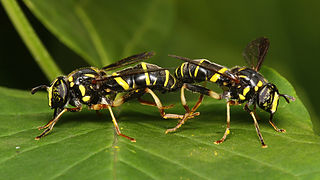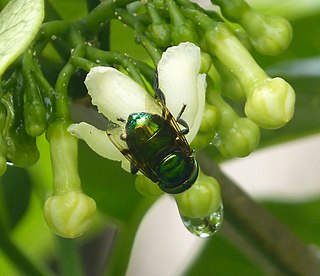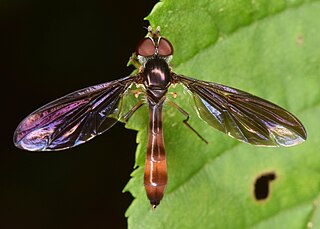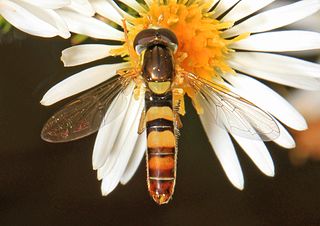
Hover flies, also called flower flies or syrphid flies, make up the insect family Syrphidae. As their common name suggests, they are often seen hovering or nectaring at flowers; the adults of many species feed mainly on nectar and pollen, while the larvae (maggots) eat a wide range of foods. In some species, the larvae are saprotrophs, eating decaying plant and animal matter in the soil or in ponds and streams. In other species, the larvae are insectivores and prey on aphids, thrips, and other plant-sucking insects.

Spilomyia is a genus of hoverflies. Many species in the genus show Batesian mimicry of wasp models, including black and yellow patterns and modified antenna shape.

Campiglossa is a genus of fruit flies in the family Tephritidae. There are at least 190 described species in Campiglossa.
Parastenopa is a genus of fruit flies in the family Tephritidae. There are about 10 described species in Parastenopa.

Toxomerus is a very large genus of hoverflies. They are found in many parts of North and South America. Most larvae are predators on soft bodied insects, though a few species have been shown to feed on pollen. Adults feed on the pollen of a wide range of flowers.

Ferdinandea is a genus of syrphid flies or hoverflies in the family Syrphidae. There are about 16 described species in Ferdinandea.
Nausigaster is a genus of syrphid flies, or hoverflies, in the family Syrphidae. Larvae have been recorded from decaying cacti and bromeliads.

Brachystomatinae is a subfamily of flies belonging to the family Empididae.
Epochrinopsis is a genus of the family Tephritidae, better known as fruit flies.

Copestylum violaceum, the purple bromeliad fly, is a species of syrphid fly in the family Syrphidae.

Hadromyia is a genus of hoverflies in the family Syrphidae. There are about seven described species in Hadromyia.

Somula decora , the Spotted Wood Fly, is an uncommon species of syrphid fly observed in central to eastern North America. Hoverflies can remain nearly motionless in flight. The adults are also known as flower flies for they are commonly found on flowers, from which they get both energy-giving nectar and protein-rich pollen. The larvae live in decaying wood.

Somula is a genus of syrphid flies in the family Syrphidae. There are at least two described species in Somula.
Copestylum fornax is a species of syrphid fly in the family Syrphidae.

Ornidia obesa is a species of syrphid fly in the family Syrphidae.

Hypocritanus fascipennis is a species of syrphid fly in the family Syrphidae. Until 2020, it was classified in the genus Ocyptamus.

Sphaerophoria contigua is a species of syrphid fly in the family Syrphidae.
Salpingogaster is a genus of syrphid flies in the family Syrphidae. There are at least 30 described species in Salpingogaster.
Dorylomorpha is a genus of flies belonging to the family Pipunculidae.















